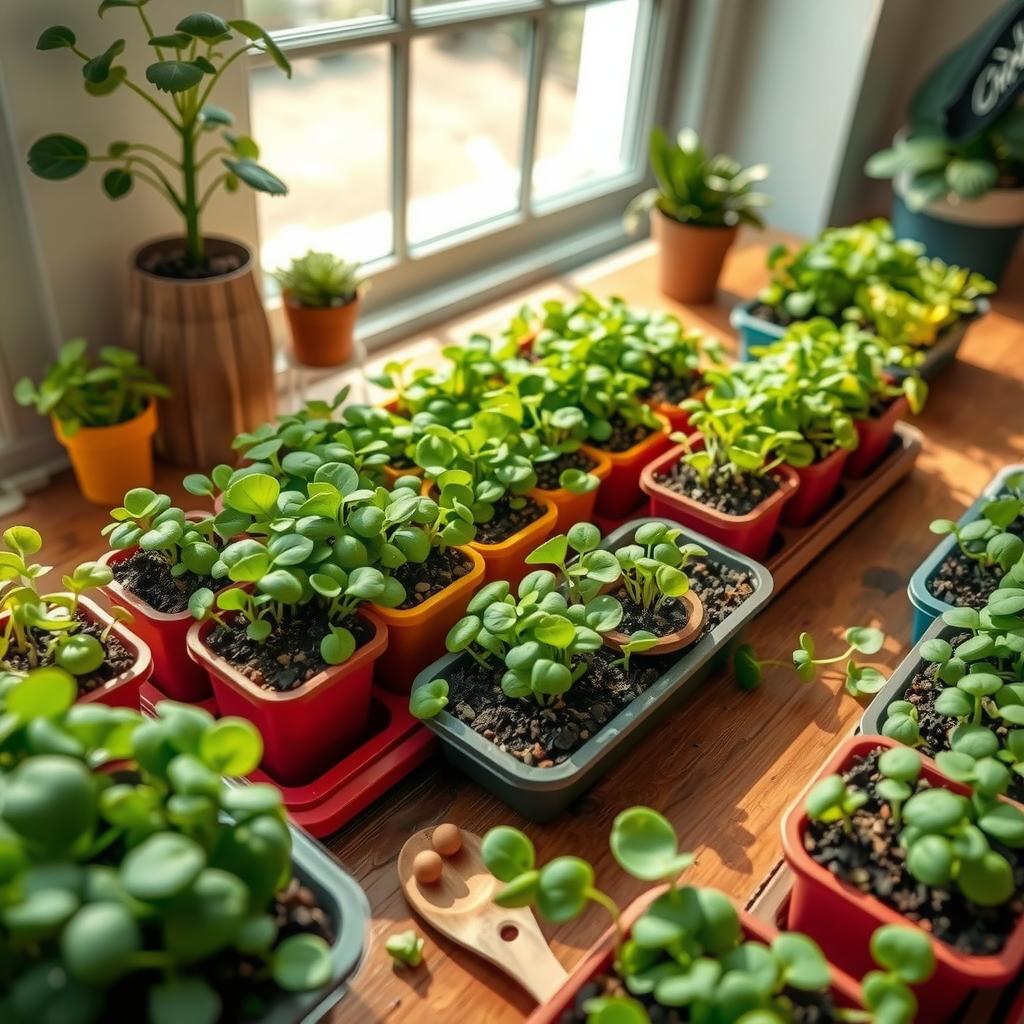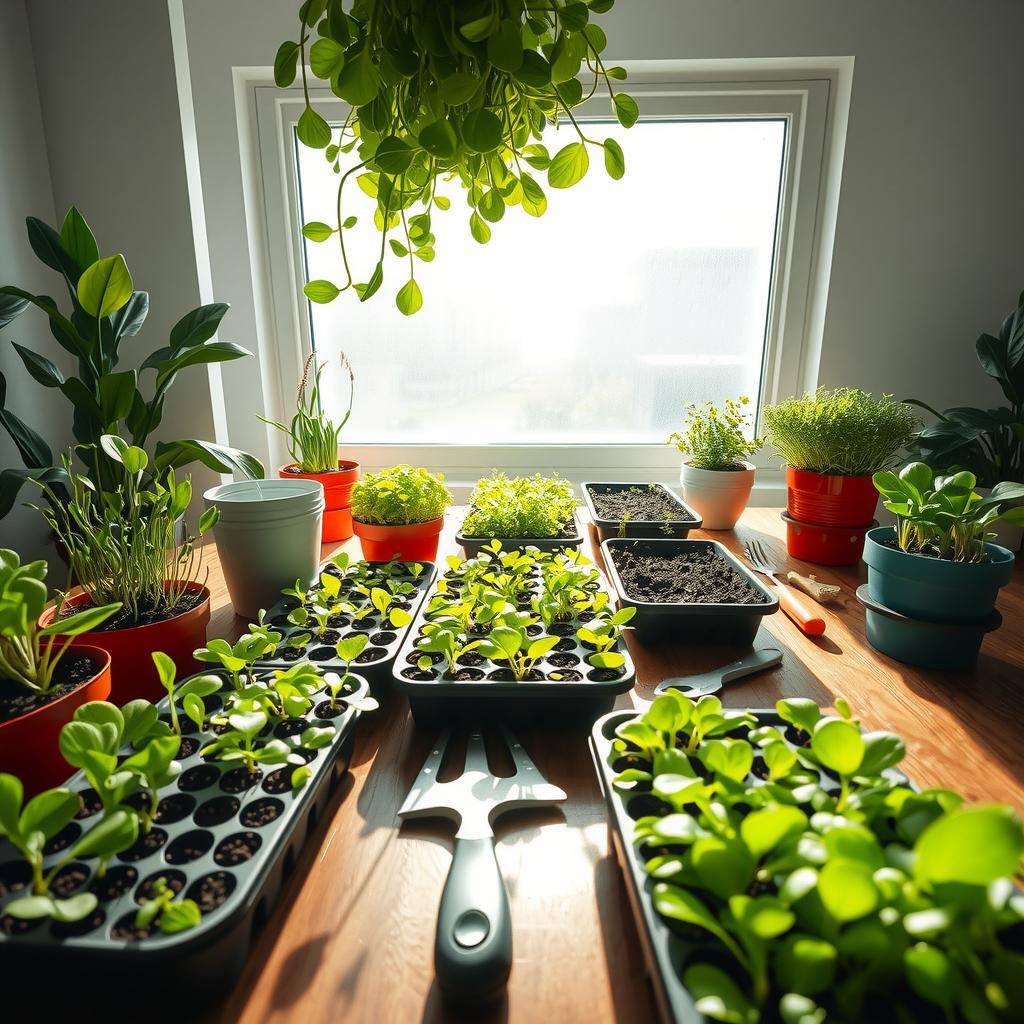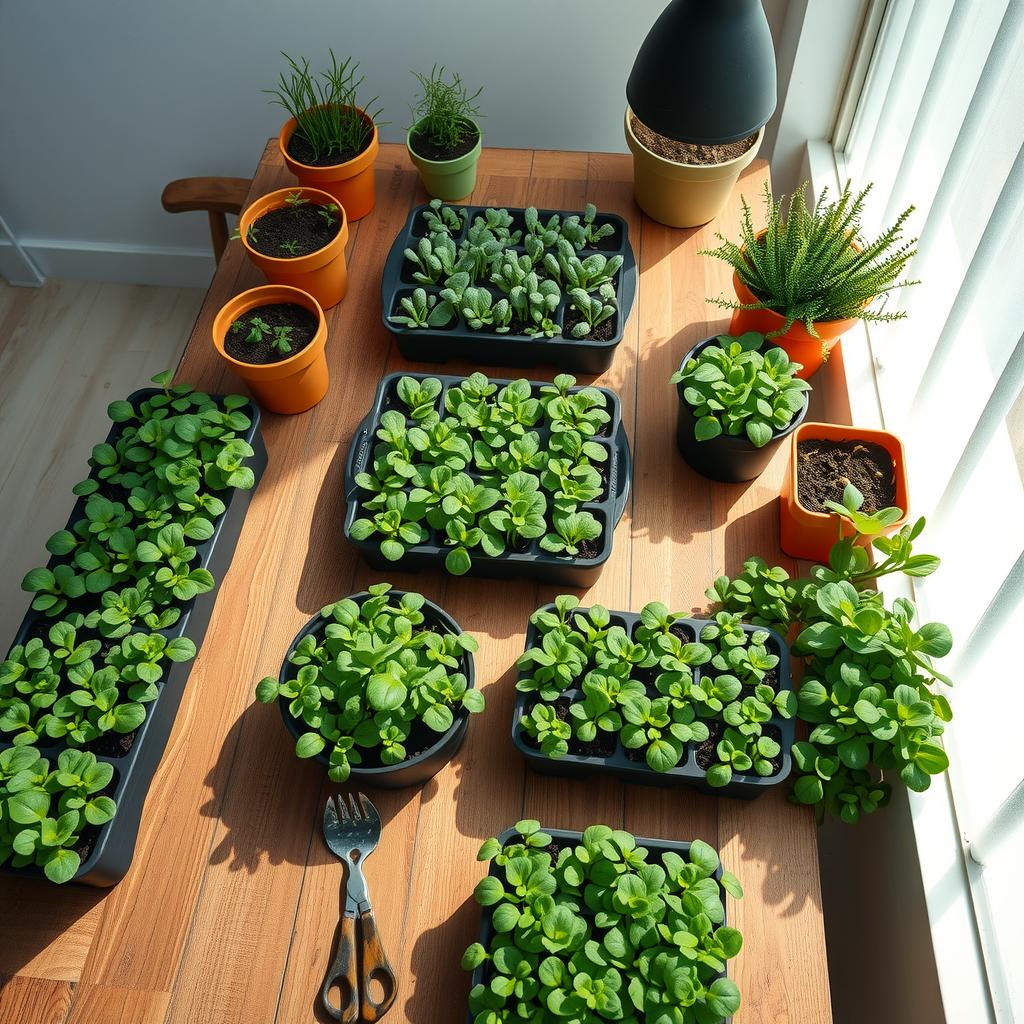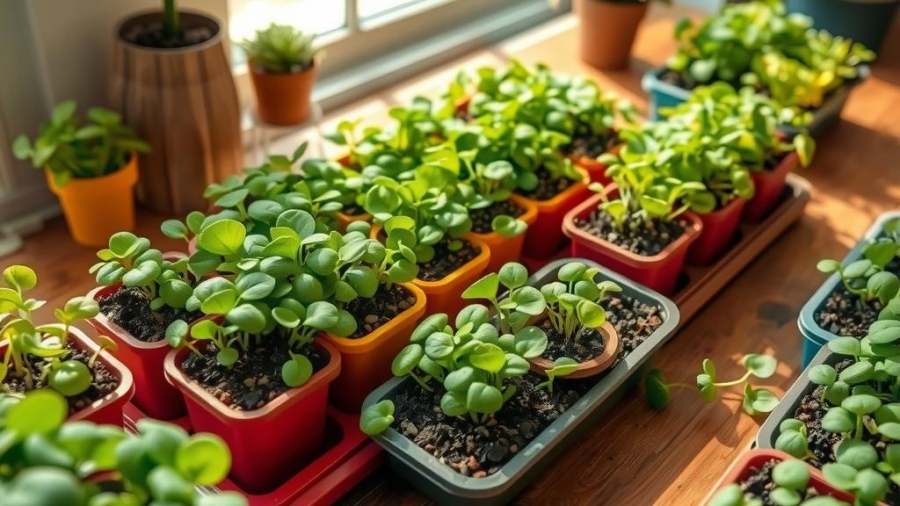Have you ever wondered how to grow your own nutritious greens right in the comfort of your home? In a world increasingly focused on sustainable agriculture and healthy living, the demand for fresh, nutrient-rich plants has never been higher. This is where indoor microgreens cultivation comes into play. These tiny powerhouses are packed with flavor and essential nutrients, making them an ideal addition to any meal or smoothie. But how can one embark on this rewarding journey of indoor farming?
This cultivation guide aims to demystify the process of growing microgreens indoors, providing practical gardening tips that cater to both beginners and experienced gardeners alike. Microgreens not only offer a quick turnaround time — often ready for harvest within 7-21 days — but they also require minimal space and resources compared to traditional gardening methods. By learning effective growing techniques tailored for limited spaces, anyone can enjoy the satisfaction of nurturing their very own mini-garden.
As readers delve deeper into this article, they will discover essential insights about soil health and light requirements necessary for optimal plant growth. The guide emphasizes various strategies that ensure successful germination and thriving microgreen crops throughout all seasons—an important aspect considering varying climates may pose challenges to outdoor gardening enthusiasts.
Ultimately, adopting indoor microgreens cultivation practices empowers individuals not just with self-sufficiency but also enhances their connection with food sources. Whether it’s enhancing culinary dishes or adding vibrant colors to salads, these little greens pack a punch that benefits overall well-being while contributing positively towards sustainable living efforts.
Join us as we explore the fascinating world of indoor gardening through our comprehensive indoor microgreens cultivation guide. With each section designed thoughtfully around enriching knowledge about these miniature plants, readers will find themselves equipped with everything needed to turn their homes into green sanctuaries filled with life!

Key points:
-
Seed Selection for Success: Choosing the right seeds is crucial for a thriving indoor microgreens garden. The Indoor microgreens cultivation guide recommends selecting high-quality, organic seeds that are specifically suited for indoor farming. Popular varieties include arugula, radish, and sunflower due to their quick growth rates and vibrant flavors. By understanding which seeds yield the best results in terms of taste and nutrient density, aspiring gardeners can ensure a bountiful harvest filled with nutrient-rich plants.
-
Optimal Light Conditions: Proper lighting is essential for maximizing plant growth in an indoor setting. The Indoor microgreens cultivation guide emphasizes using grow lights or placing trays near south-facing windows to provide adequate light exposure. It advises on ideal light duration—generally 12-16 hours per day—to promote vigorous growth while preventing leggy or weak plants. These gardening tips help individuals create an environment where microgreens can flourish, leading to lush crops even within limited space.
-
Soil Health Management: Maintaining healthy soil is fundamental to successful home gardening practices when cultivating microgreens indoors. The Indoor microgreens cultivation guide suggests utilizing a quality seed-starting mix enriched with organic matter that supports root development and nutrient absorption. Regularly monitoring moisture levels and avoiding overwatering ensures that the soil remains conducive to plant health while minimizing waste through efficient resource management—a key principle of sustainable agriculture embraced by modern growers seeking self-sufficiency at home.

The Nutritional Benefits of Microgreens
Tiny Greens, Big Impact
Microgreens are not just a trendy addition to culinary dishes; they are powerhouses of nutrition that can significantly enhance one’s diet. These young plants, typically harvested just after the first true leaves emerge, boast concentrated levels of vitamins, minerals, and antioxidants compared to their mature counterparts. Research has shown that microgreens can contain up to 40 times more nutrients than fully grown vegetables. For instance, studies indicate that varieties such as red cabbage and cilantro exhibit impressive concentrations of vitamin C and E—crucial for immune function and skin health respectively. Furthermore, the phytochemicals found in these greens may help reduce inflammation and combat oxidative stress within the body.
Incorporating microgreens into meals is an excellent strategy for those looking to boost their overall nutrient intake without drastically altering their cooking routines. Whether sprinkled atop salads or blended into smoothies, these vibrant little greens add flavor while packing a serious nutritional punch. As people become increasingly aware of health trends and sustainable agriculture practices, home gardening enthusiasts have begun exploring ways to grow these nutritious plants indoors using guides like the Indoor Microgreens Cultivation Guide.
Why Microgreens Are Essential for a Healthy Diet
Small Size but Mighty Nutrition
The importance of incorporating microgreens into daily meals cannot be overstated—they serve as an effective means of enhancing dietary diversity while promoting overall well-being. Rich in essential nutrients such as magnesium, iron, calcium, potassium—and various phytonutrients—these tiny greens contribute positively toward improved soil health when cultivated properly in home gardens or indoor farming setups. Notably beneficial for cardiovascular health due to their high antioxidant content; consuming microgreens regularly helps maintain optimal blood pressure levels by preventing arterial plaque buildup.
Moreover, growing techniques associated with indoor farming have made it possible for individuals living in urban environments with limited access to fresh produce sources still enjoy these nutrient-rich plants all year round—with minimal effort involved! Utilizing methods outlined in resources like the Indoor Microgreens Cultivation Guide, aspiring gardeners can efficiently cultivate diverse varieties suited specifically to their tastes while ensuring sustainability throughout the process.
Sustainable Agriculture Through Microgreen Cultivation
A Step Toward Eco-Friendly Eating
Embracing microgreen cultivation aligns seamlessly with sustainable agriculture principles—an approach aimed at minimizing environmental impact while maximizing food production efficiency. These small yet mighty crops require fewer resources than traditional farming methods: less water consumption combined with shorter growth cycles translates directly into reduced carbon footprints associated with transporting produce from farms distant from consumers’ homes. Additionally—and perhaps most importantly—the ability to grow them indoors promotes accessibility among communities often overlooked by conventional agricultural systems.
By engaging actively in home gardening initiatives centered around growing nutrient-dense crops like microgreens using innovative techniques presented through helpful tools such as the Indoor Microgreens Cultivation Guide, individuals contribute personally towards greater system-wide changes favoring eco-conscious lifestyles! This empowerment fosters resilience against fluctuating food prices whilst nurturing connections between local ecosystems—all critical components driving forward collective efforts geared towards sustainable eating habits today!
Enhancing Flavor Profiles With Nutrient-Rich Greens
Culinary Versatility Meets Health Enhancement
Microgreens offer culinary enthusiasts an opportunity not only to elevate flavors but also enrich meals nutritionally—all thanks largely due multifaceted versatility inherent within this category plant family! From spicy radish shoots adding zingy kick tacos right sweet basil sprigs adorning gourmet pizzas; there truly exists no limit scope creativity involved when utilizing varied selections available across marketplace shelves today!
Additionally woven intricately throughout discussions surrounding healthy eating habits lies undeniable correlation between enhanced taste experiences derived through incorporating visually appealing arrangements curated alongside vibrant colored offerings showcased prominently on plates table settings alike-stirring excitement enjoyment during mealtime rituals shared amongst families friends gathering together—not merely fueling bodies nourishing souls too! Thus integrating pioneering approaches recommended via insightful literature exemplified through comprehensive resources including esteemed works like the Indoor Microgreen Cultivation Guide serves dual purpose facilitating both deliciousness sustainability collectively enriching lives holistically beyond mere sustenance alone ultimately creating lasting impact future generations aspire thrive amidst evolving landscape 21st-century dining culture established firmly rooted foundation respect responsibility toward planet wellbeing cherished humanity itself.

Setting Up Your Indoor Garden: Essential Tools and Techniques
Creating an Ideal Environment for Growing Microgreens
Establishing a flourishing indoor garden requires an understanding of essential tools and techniques that cater specifically to the needs of microgreens. This indoor microgreens cultivation guide emphasizes creating a conducive environment for plant growth, which starts with selecting the right equipment. First, adequate lighting is crucial; many growers opt for LED grow lights as they provide optimal brightness while being energy-efficient. These lights should mimic natural sunlight by offering both blue and red light spectrums, fostering strong photosynthesis in these nutrient-rich plants.
In addition to proper lighting, choosing suitable containers is another key aspect of successful indoor farming. Shallow trays or pots are ideal for microgreens since they do not require extensive root depth but benefit from ample surface area for seed distribution. It’s also vital to use quality soil that promotes excellent drainage while retaining moisture—this balance helps maintain soil health over time.
Watering techniques play a significant role in cultivating vibrant microgreens indoors. Employing methods like bottom watering can prevent over-saturation on the foliage, thus mitigating mold risk—a common challenge in home gardening scenarios. Furthermore, humidity levels should be monitored closely; utilizing a simple humidity dome can create an ideal mini-greenhouse effect during germination phases.
Temperature control cannot be overlooked either; maintaining warmth around 65-75°F (18-24°C) enhances seed germination and overall plant vigor. Regularly checking temperature fluctuations ensures consistent growth rates across different crops throughout their lifecycle.
As part of sustainable agriculture practices, it’s advisable to select organic seeds whenever possible—these often yield healthier plants free from chemical treatments that could otherwise affect flavor or nutrient profile negatively. Moreover, keeping detailed notes on growing techniques employed will aid any future endeavors in refining one’s approach based on past experiences.
Lastly, incorporating companion planting strategies within your indoor space can boost productivity further by promoting biodiversity among your crops—a principle rooted deeply in traditional gardening wisdom but highly applicable even within small-scale setups such as those used for growing microgreens at home.
By adhering to these comprehensive guidelines outlined above through this indoor microgreens cultivation guide, individuals can successfully embark on their journey into indoor gardening while reaping its manifold benefits including access to fresh produce year-round right from their kitchens!
Innovative Approaches to Soil Health in Indoor Farming
Enhancing Soil Quality Through Sustainable Practices
In the realm of indoor farming, soil health is paramount for fostering robust plant growth and ensuring sustainable agricultural practices. The Indoor microgreens cultivation guide emphasizes the importance of utilizing organic materials such as compost and biochar to enrich the soil, thereby promoting a thriving ecosystem within confined spaces. These eco-friendly amendments not only enhance nutrient availability but also improve water retention, critical for maintaining moisture levels in indoor environments. By adopting these sustainable methods, growers can cultivate nutrient-rich plants that flourish while simultaneously supporting environmental stewardship.
Additionally, implementing crop rotation and companion planting strategies can significantly benefit soil health by naturally suppressing pests and diseases. For instance, incorporating legumes into an indoor gardening setup can enhance nitrogen fixation, enriching the soil without synthetic fertilizers. Such practices align with sustainable agriculture principles by minimizing chemical inputs that may harm beneficial microorganisms essential for healthy soils. Furthermore, using cover crops during off-seasons provides ground cover that reduces erosion and improves organic matter content when tilled back into the earth.
The integration of hydroponic systems also plays a crucial role in promoting optimal conditions for plant development while conserving resources. By controlling pH levels and nutrient solutions directly delivered to roots, growers maximize efficiency while reducing waste associated with traditional growing techniques. This method complements traditional soil-based practices outlined in various gardening tips found within the Indoor microgreens cultivation guide, showcasing how innovative approaches contribute not only to personal food security but also to broader ecological sustainability.
Water Conservation Techniques in Indoor Farming
Efficient Water Management Strategies for Eco-Friendly Cultivation
Water conservation is central to any discussion on sustainable practices within indoor farming environments. Given that many urban areas face challenges related to water scarcity, employing efficient irrigation techniques becomes imperative for responsible home gardening initiatives. Utilizing drip irrigation systems allows precise water delivery directly at plant roots—ensuring minimal evaporation loss compared with conventional watering methods—and thus optimizing resource use effectively.
Moreover, integrating rainwater harvesting systems into one’s gardening framework encourages more eco-conscious consumption patterns by reusing natural resources efficiently—a practice highlighted extensively throughout the Indoor microgreens cultivation guide as one of many smart strategies available today! Additionally, employing closed-loop aquaponics setups combines fish farming with plant cultivation; this symbiotic relationship creates an efficient cycle where waste produced by fish acts as natural fertilizer enhancing overall system productivity while reducing reliance on external inputs.
By focusing on water-efficient technologies alongside educational resources like comprehensive guides tailored specifically towards aspiring indoor farmers or seasoned horticulturists alike—including curated lists featuring specific strains ideal suited towards maximizing flavor profile diversity—growers further ensure their efforts yield both delicious gourmet harvests AND contribute positively toward global sustainability goals!
Biodiversity Promotion through Companion Planting
Cultivating Diverse Ecosystems Within Indoor Gardens
Implementing biodiversity through companion planting emerges as another vital strategy within sustainable indoor agriculture contexts—enabling cultivators not just achieve greater yields from limited space but equally create resilient ecosystems capable of self-regulation against pests/diseases over time! The concept encourages pairing compatible species together which fortify each other’s growth potential; this method aligns perfectly well with insights gleaned from reputable sources such as renowned books including an introductory overview featured prominently under sections dedicated specifically towards highlighting benefits derived from strategic pairings among different types (e.g., radishes planted alongside kale).
Furthermore—the established relationships resulting between certain pairs often lead toward increased pollinator attraction thereby enhancing overall productivity across entire gardens whilst minimizing dependence upon harmful pesticides commonly utilized elsewhere; these holistic methodologies resonate deeply amongst advocates championing regenerative agricultural movements aimed ultimately at restoring balance back into our disrupted ecosystems worldwide! In summary: embracing diversity fosters resilience & adaptability amidst ever-changing climatic conditions observed currently globally—which translates beautifully onto small-scale operations run right inside homes everywhere thanks largely due diligence afforded via detailed guides now readily accessible online today!
FAQ:
Q: What are microgreens, and why should I grow them indoors?
A: Microgreens are young, edible plants harvested just after the first true leaves appear. They are packed with flavor and nutrients, making them a fantastic addition to any diet. Growing microgreens indoors allows individuals to practice sustainable agriculture by reducing their reliance on store-bought produce while ensuring access to fresh, nutrient-rich plants. The Indoor microgreens cultivation guide provides essential insights into how anyone can successfully cultivate these vibrant greens in their home environment.
Q: What factors influence the success of growing microgreens at home?
A: Several key elements affect the growth of microgreens. These include light exposure, soil quality, and watering techniques. Ensuring adequate light—whether natural or artificial—is crucial for optimal plant growth. Additionally, maintaining soil health through proper nutrient balance is emphasized in the Indoor microgreens cultivation guide, which offers practical gardening tips that cater to both novice and experienced gardeners alike.
Q: How can I maximize my indoor garden’s yield using sustainable practices?
A: To maximize yields while adhering to sustainable practices, it’s important to focus on efficient use of resources like water and soil amendments. Techniques such as crop rotation within your indoor farming setup or composting kitchen scraps contribute positively to overall soil health. The Indoor microgreens cultivation guide highlights various methods that not only enhance productivity but also promote a more eco-friendly approach to home gardening—allowing individuals to enjoy lush harvests without compromising environmental integrity.
